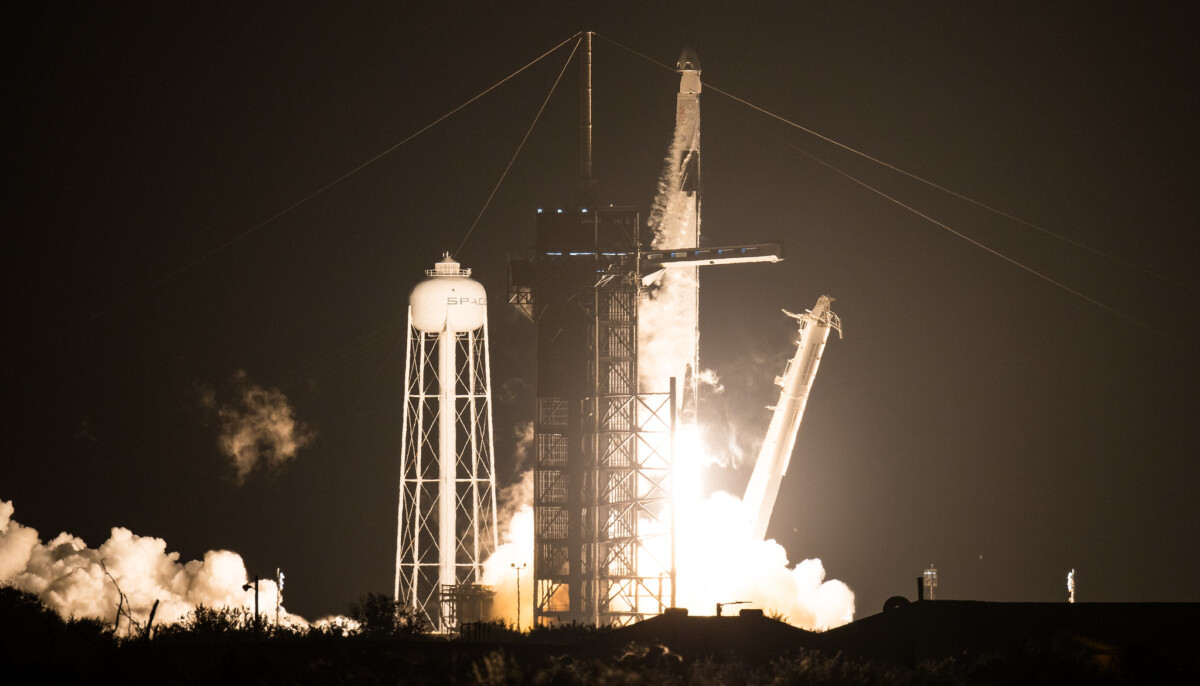The papers are in! And that means the spacecraft is now allowed to shuttle routinely between Earth and the ISS.
Last night the time had come: the start of the first real mission within the Commercial Crew program. Four astronauts left for the ISS on board the certified Crew Dragon. “I couldn’t be more proud of the work we’ve done here,” said SpaceX’s Gwynne Shotwell.
Mission
The so-called Crew-1 mission follows the manned test flight that took place at the end of May. At the time, NASA astronauts Robert Behnken and Douglas Hurley traveled to the ISS aboard SpaceX’s Crew Dragon. The launch marked the start of a new era, in which commercial space organizations will also commute back and forth to the ISS to deliver and collect astronauts. At the same time, Crew Dragon’s first manned flight was a final test flight, extensively testing the space capsule as well as the missile system and all systems on board.
The papers are in!
Then the two astronauts again landed safely on earth, this last test flight was considered a success. And then it was up to NASA. NASA has recently been busy assessing all the data collected during the test flight. And after a thorough analysis, SpaceX was given the green light. It means SpaceX now holds the necessary certificate to be the first commercial company to travel back and forth to the ISS on behalf of NASA.
Launch
SpaceX did not completely wait for this official moment. The next manned mission to the ISS has already been completed on the agenda for a while. But now that the official papers have been received, SpaceX can finally go. This happy moment took place last night. From the Kennedy Space Center in Florida, the manned Crew Dragon on a Falcon-9 rocket successfully took to the skies. On board are Crew Dragon commander Michael Hopkins, pilot Victor Glover and mission specialist Shannon Walker – all from NASA – along with Japanese mission specialist Soichi Noguchi. “Facon 9 looked great,” said Shotwell. “Dragon was delivered in a beautiful track after about twelve minutes.” Fortunately, the launch went smoothly. “Seeing the launch was a very special moment for NASA and our SpaceX team,” said Steve Stich, manager of NASA’s Commercial Crew Program. “We look forward to having this crew on the Space Station to continue our important work there.”
Primeurs
This Crew-1 mission has a number of firsts to its name. First of all, this is the first of a total of six manned missions that NASA and SpaceX will be conducting under the Commercial Crew Program. The Crew-1 mission is therefore the first flight of a NASA-certified spacecraft, designed to transport crew members and deliver goods to the ISS. In addition, for the first time, four astronauts will now arrive at the ISS at the same time. Only three astronauts can join the Russian Soyuz. The four astronauts will join the three astronauts already on the International Space Station. And this brings the total crew of the space station to seven astronauts; one more than usual. Finally, it is the first time that NASA has issued a permit to launch humans into low Earth orbit.
The four crew members will be on the space station for six months. And that’s been quite a while. It will therefore be the longest manned space mission launched from the United States. Incidentally, this is a breeze for the vessel. The Crew Dragon is built to be able to hang on the ISS for at least 210 days. The crew members don’t have to get bored during their stay either. NASA hopes to do more research with the extra large crew. In addition, there are also a few spacewalks on the agenda. The astronauts will then return home in the spring of 2021.
The first official manned flight to the ISS is of course a boost for SpaceX, which has been working towards this for years. But flight is also very important for NASA. “NASA keeps its promise to the American people and our international partners to provide safe, reliable and cost-effective missions to the ISS, leveraging US private industry,” said NASA Chief Jim Bridenstine. “This is an important mission for NASA, SpaceX and our partners at JAXA. We look forward to seeing the crew arrive on the ISS and continue our partnership for all of humanity. ”
In addition, NASA can now focus on bigger things: the moon and later even Mars. NASA wants in the short term – sometime in 2024 – putting people on the moon again and with the knowledge and skills gained during these moon missions, also set up manned missions to Mars. Because commercial parties will now partly arrange the provisioning and crewing of the ISS, NASA can fully focus on those ambitions. In the meantime, work on board the ISS continues as usual. And the latter is important; many experiments being done in the ISS and technology being (further) developed in the ISS will eventually pave the way for a long stay on other celestial objects, such as the moon and Mars. Yesterday’s launch is therefore part of a much bigger story. A story that goes far beyond the orbit of the ISS.
–
Keep amazed ✨
Receive the most beautiful space photos and interesting popular science articles every Friday. Get the free Scientias Magazine together with 50,000 others.


:quality(80)/cdn-kiosk-api.telegraaf.nl/e446f094-27fe-11eb-b6e3-0217670beecd.jpg)